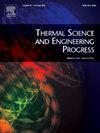Numerical simulation on thermal response of thermal camouflage film using phase change material capsules
IF 5.4
3区 工程技术
Q2 ENERGY & FUELS
引用次数: 0
Abstract
Thermal camouflage films containing phase change material capsules hold great potential for precise thermal camouflage in complex environments. This study examines the heat transfer characteristics of these films under various heating conditions. A heat transfer model is developed to analyze the thermal response of the film, including temperature distribution and phase change material liquid fraction, considering the effects of heating temperature, phase change material enthalpy, and capsule diameter. The impact of different capsule arrangements on camouflage performance is also investigated. The results reveal a three-stage heating process: initial, middle, and final. While the films provide effective thermal camouflage for a specific period, the camouflage patterns eventually degrade. Higher heating temperatures accelerate the onset of camouflage but reduce its effective duration. For phase change material enthalpy, the film with 240 kJ/kg exhibited melting times 31.4 % and 13.6 % longer than those with 120 kJ/kg and 180 kJ/kg, respectively. Regarding capsule diameter, the 6 mm capsules extended the middle heating stage by 40.0 % and 16.7 % compared to 4 mm and 5 mm capsules, respectively.
相变材料胶囊热伪装膜热响应的数值模拟
包含相变材料胶囊的热伪装膜在复杂环境下的精确热伪装具有很大的潜力。本研究考察了这些薄膜在不同加热条件下的传热特性。考虑加热温度、相变材料焓和胶囊直径的影响,建立了传热模型,分析了膜的热响应,包括温度分布和相变材料液分数。研究了不同胶囊布置方式对伪装性能的影响。结果表明加热过程分为三个阶段:初始、中间和最终。虽然薄膜在特定时期提供有效的热伪装,但伪装模式最终会退化。较高的加热温度加速了伪装的开始,但减少了其有效持续时间。对于相变材料焓,240 kJ/kg的相变膜比120 kJ/kg和180 kJ/kg的相变膜的熔化时间分别长31.4%和13.6%。就胶囊直径而言,6 mm胶囊比4 mm和5 mm胶囊分别延长了加热中期的40.0%和16.7%。
本文章由计算机程序翻译,如有差异,请以英文原文为准。
求助全文
约1分钟内获得全文
求助全文
来源期刊

Thermal Science and Engineering Progress
Chemical Engineering-Fluid Flow and Transfer Processes
CiteScore
7.20
自引率
10.40%
发文量
327
审稿时长
41 days
期刊介绍:
Thermal Science and Engineering Progress (TSEP) publishes original, high-quality research articles that span activities ranging from fundamental scientific research and discussion of the more controversial thermodynamic theories, to developments in thermal engineering that are in many instances examples of the way scientists and engineers are addressing the challenges facing a growing population – smart cities and global warming – maximising thermodynamic efficiencies and minimising all heat losses. It is intended that these will be of current relevance and interest to industry, academia and other practitioners. It is evident that many specialised journals in thermal and, to some extent, in fluid disciplines tend to focus on topics that can be classified as fundamental in nature, or are ‘applied’ and near-market. Thermal Science and Engineering Progress will bridge the gap between these two areas, allowing authors to make an easy choice, should they or a journal editor feel that their papers are ‘out of scope’ when considering other journals. The range of topics covered by Thermal Science and Engineering Progress addresses the rapid rate of development being made in thermal transfer processes as they affect traditional fields, and important growth in the topical research areas of aerospace, thermal biological and medical systems, electronics and nano-technologies, renewable energy systems, food production (including agriculture), and the need to minimise man-made thermal impacts on climate change. Review articles on appropriate topics for TSEP are encouraged, although until TSEP is fully established, these will be limited in number. Before submitting such articles, please contact one of the Editors, or a member of the Editorial Advisory Board with an outline of your proposal and your expertise in the area of your review.
 求助内容:
求助内容: 应助结果提醒方式:
应助结果提醒方式:


